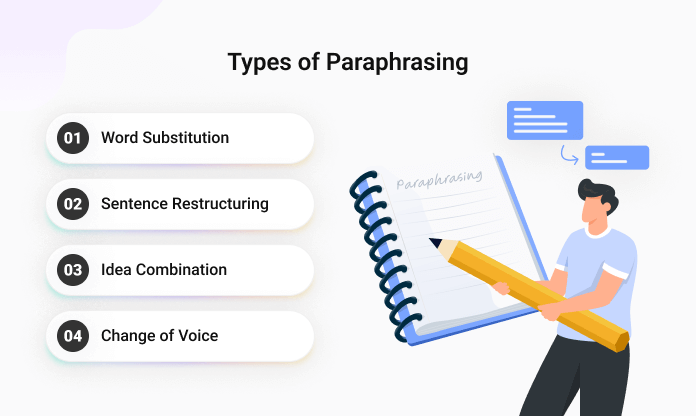
Paraphrasing is the process of rephrasing a piece of text or speech in your own words while preserving the original meaning. It involves expressing the same ideas presented in the original source but using different words and sentence structures.
The definition of paraphrasing in different dictionaries is as follows:
“To repeat something written or spoken using different words, in a way that makes the original meaning clearer.”
“A restatement of a text, passage, or work giving the meaning in another form”
Paraphrasing is often used to simplify, clarify, or change the original information for a specific purpose. It is used in academic and professional fields to avoid plagiarism.
Paraphrasing can be done using different techniques depending on the context and the desired effect. The four basic types of paraphrasing are:

This technique involves replacing specific words or phrases with synonyms while maintaining the original sentence structure.
It is useful when changing the text for a different reading level and helps to make the text more formal or informal as needed.
Examples:
Original | Paraphrase |
"The dog chased the ball across the park." | "The canine pursued the sphere throughout the green space." |
“The children laughed at the funny clown.” | “The youngsters chuckled at the humorous jester.” |
“The scientist conducted an experiment to test the hypothesis.” | “The researcher performed a trial to examine the theory.” |
In all these cases, the paraphrases maintain the original meaning and context of the sentences but use different words to express the same ideas. For example changing ‘dog’ to ‘canine’, ‘humorous to funny’, and ‘experiment’ to ‘trial’.
This method involves changing the order of clauses or phrases or breaking down complex sentences into simpler ones.
This is especially useful for making complex ideas easy to understand. The stress or emphasis of the sentences can also be changed with this technique.
(How to Rephrase a Sentence: A Step-by-Step Guide by Scalenut)
(Simple Sentence - Definition and Examples)
Example:
Original | Paraphrase |
"Despite the heavy rain, the team continued to play." | "The team kept playing even though it was raining heavily." |
“Although it was raining heavily, we decided to go for a walk.” | “We chose to take a stroll despite the downpour.” |
“The CEO, who had been with the company for 20 years, announced her retirement yesterday." | "Yesterday, after two decades with the company, the CEO declared she would be stepping down." |
The structure of the sentences is transformed to provide changes and possibly emphasize different parts of the sentence. For example, starting with "Despite the heavy rain" changes to "even though it was raining heavily," or "The CEO, who had been with the company for 20 years" restructured to "after two decades with the company, the CEO."
This technique involves combining multiple sentences or ideas into a single concise sentence.
It is useful in cases with word limits to make the text short. However, it requires careful attention to not lose the details and flow of the text.
Examples:
Original | Paraphrase |
"The weather was perfect. The sun was shining brightly. There was a gentle breeze." | "The weather was idyllic with bright sunshine and a gentle breeze." |
“Exercise is good for physical health. It also improves mental well-being. Additionally, it can help with stress management.” | “Regular physical activity offers a trifecta of benefits: enhancing bodily health, boosting mental state, and aiding in stress reduction.” |
"The book was long. The book was interesting. I couldn't put it down." | "The long and interesting book captivated me completely." |
These provided examples demonstrate the technique of condensation in paraphrasing. This approach combines multiple sentences or ideas into one concise, effective statement that does not lose any important factor of the sentence.
This method involves shifting between active and passive voice to change the focus of the sentence.
(Read more paraphrasing by Changing Active to Passive - eslwritting)
Example:
Original | Active/Passive | Paraphrase | Active/Passive |
"The chef prepared the meal." | Active | "The meal was prepared by the chef." | Passive |
“Scientists have discovered a new species of frog in the Amazon rainforest.” | Active | “A new species of frog has been discovered in the Amazon rainforest by scientists.” | Passive |
“The classic novel was written by the author in just six weeks.” | Passive | “The author wrote the classic novel in just six weeks.” | Active |
Passive constructions can help focus on the action or the object affected by the action, for example, “meal,” “classic novel,” and “ new species of frog,” while active voice emphasizes the subject performing the action, e.g., “chef,” “scientists,” and “author.”